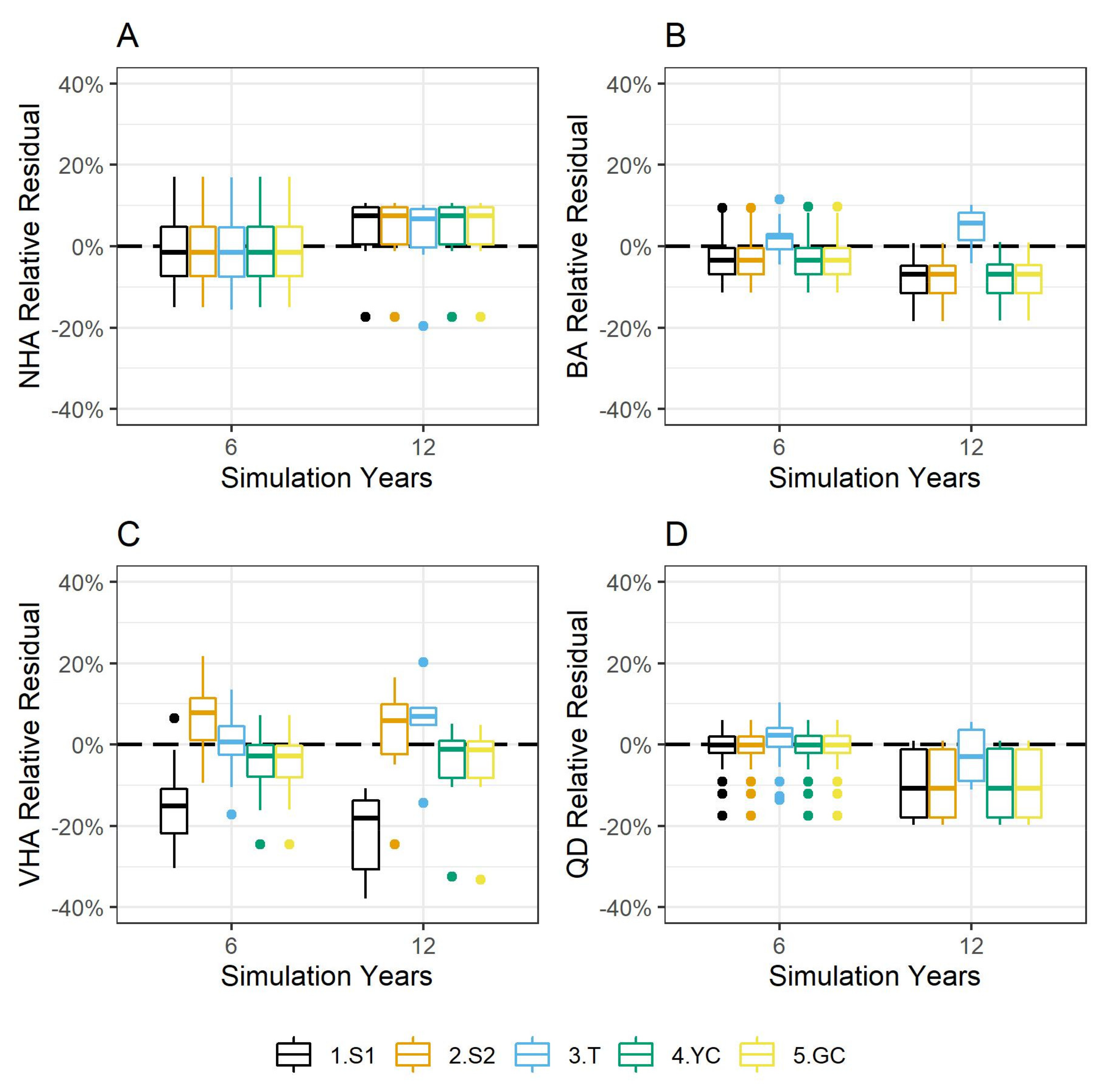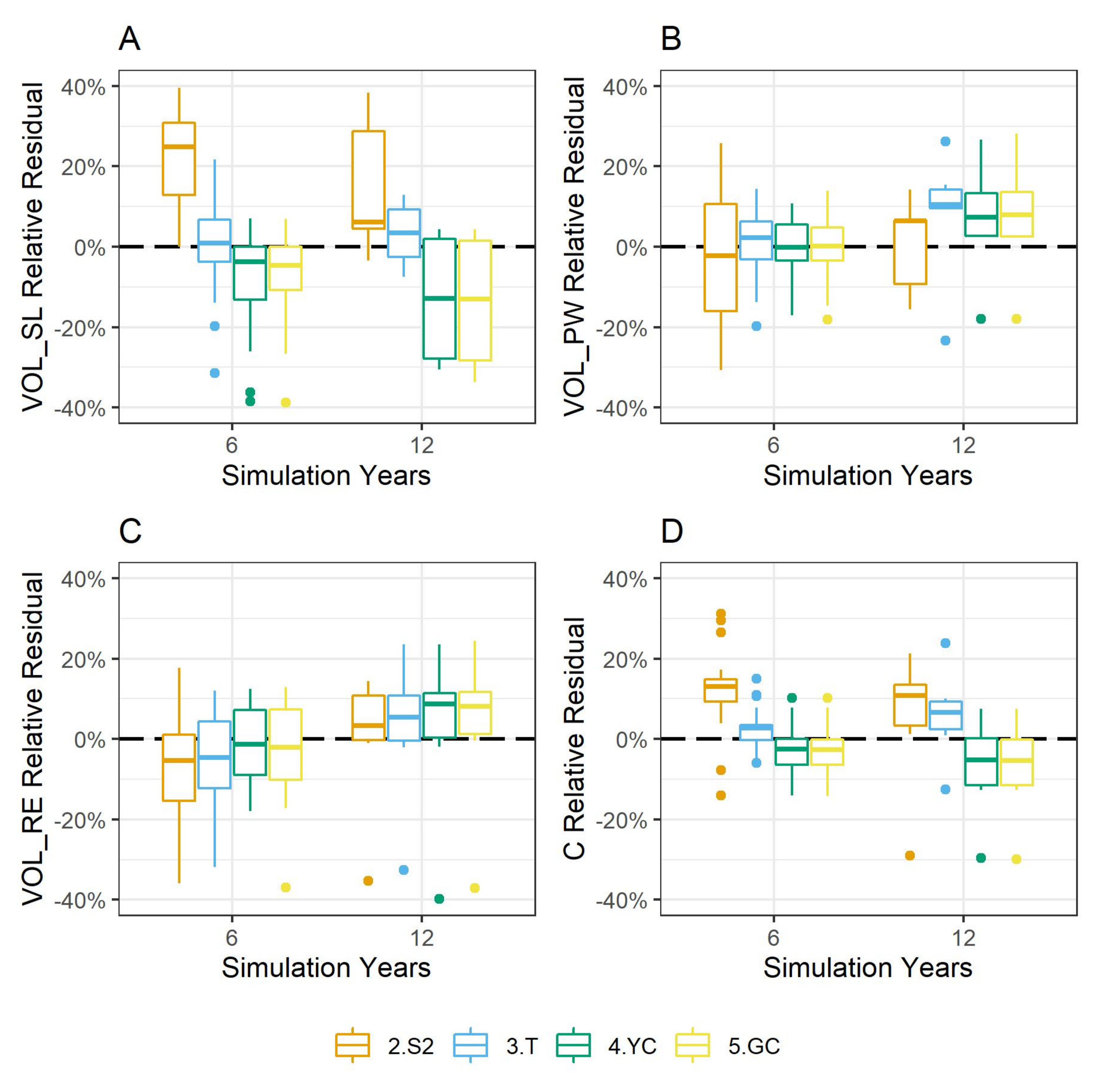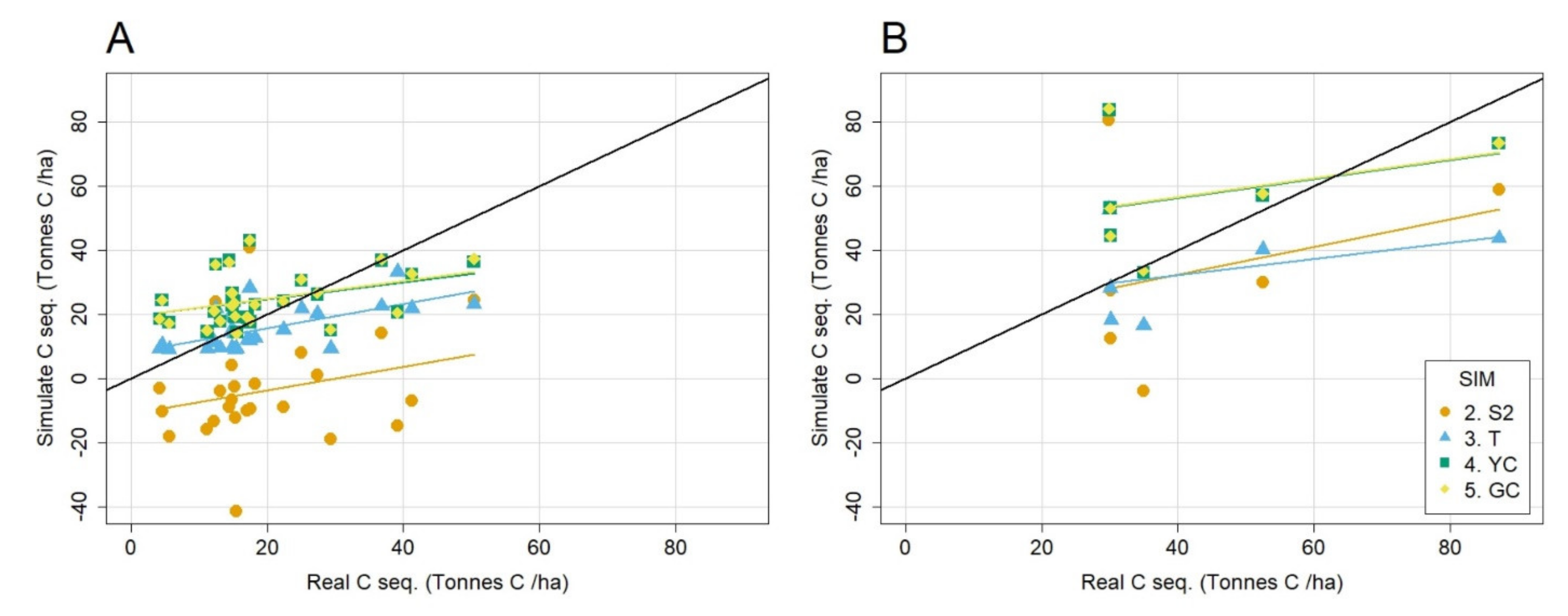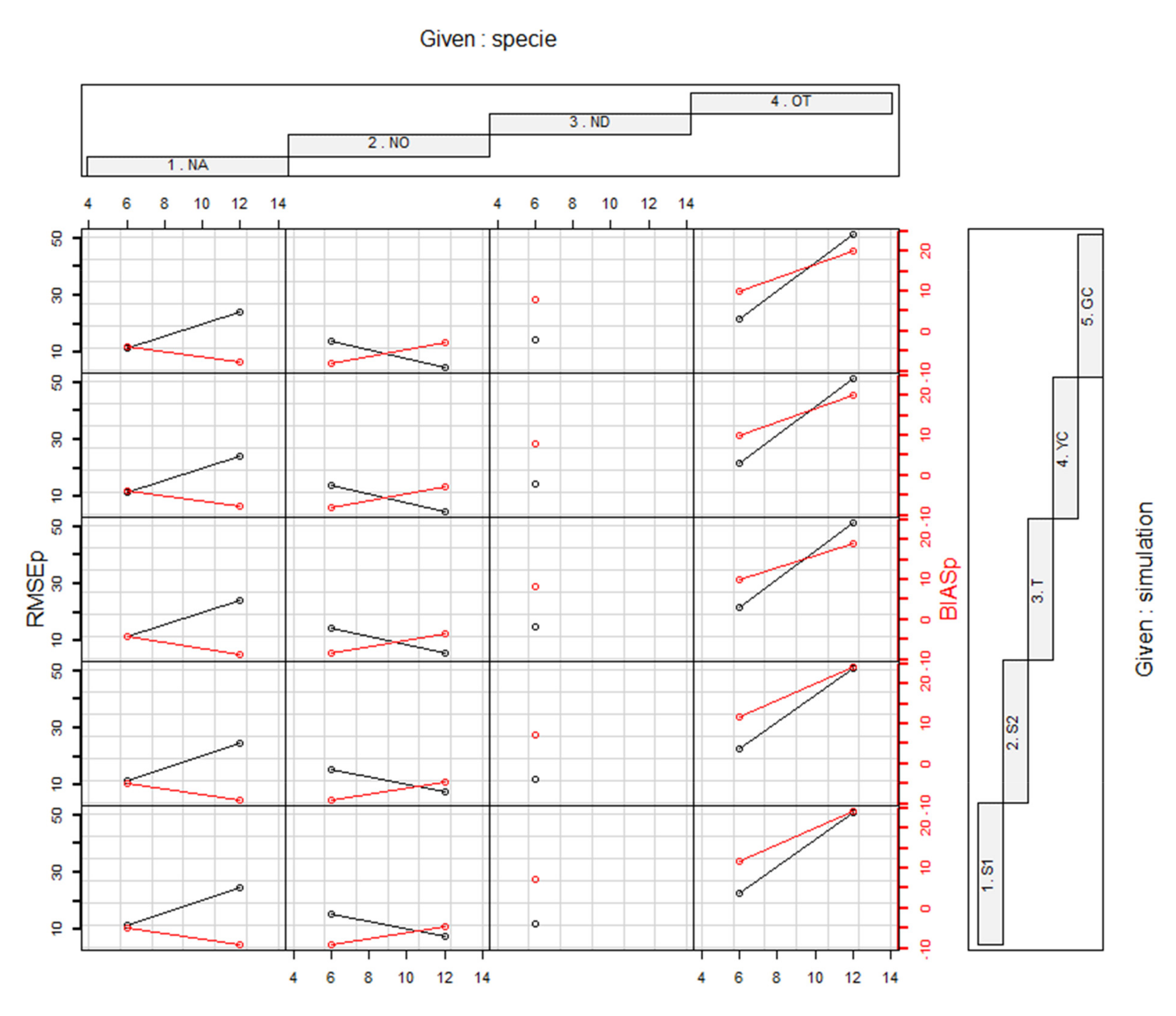Prediction Comparison of Stand Parameters and Two Ecosystem Services through New Growth and Yield Model System for Mixed Nothofagus Forests in Southern Chile
Abstract
:1. Introduction
2. Materials and Methods
2.1. Data Description
2.2. Simulations
2.2.1. Stand-Level without Diameter Distribution Simulation
2.2.2. Stand-Level with Diameter Distribution Simulation
2.2.3. Tree-Level Simulation
2.2.4. Compatibility Simulations
2.3. Evaluation of Ecosystem Services
3. Results
3.1. Number of Trees Goodness-of-Fit
3.2. Basal Area Goodness-of-Fit
3.3. Volume Goodness-of-Fit
3.4. Products Volume Goodness-of-Fit
3.5. Carbon Stocks Goodness-of-Fit
4. Discussion
5. Conclusions
Author Contributions
Funding
Acknowledgments
Conflicts of Interest
Appendix A
| Model | Est. 1 | Est. 2 | Est. 3 | Est. 4 | Est. 5 | Est. 6 |
|---|---|---|---|---|---|---|
| BAN (Equation (1)) | −6.16977 | 1.21163 | 0.65197 | 0.51841 | 1.24957 | - |
| BAC (Equation (2)) | 1.99503 | 0.09436 | −0.21578 | −1.87264 | - | - |
| PNHAN (Equation (5)) | −7.13684 | 10.29084 | −0.01404 | - | - | - |
| NHA1 (Equation (6)) | 0.003595746 ( | 1.014 ( | - | - | - | - |
| QD0max (Equation (7)) | 11.6167 | 11.3770 | 11.7630 | 11.6167 | −1.4112 | - |
| VHA (Equation (8)) | −0.934 | 0.91 | 1.0949 | −0.27 | 0.2241 | - |
| B (Equation (10)) | −4.85344986 | 1.03816837 | −0.01755607 | 11.88124162 | - | - |
| C (Equation (11)) | 3.41813315 | 0.46054858 | −0.42701842 | - | - | - |
| B (Equation (12)) | −8.83509885 | 1.06360951 | 0.99954695 | - | - | − |
| C (Equation (13)) | 3.57525492 | 0.39042726 | −0.36299573 | −4.83178811 | - | - |
| B (Equation (14)) | −6.57263098 | 1.09071507 | - | - | - | - |
| C (Equation (15)) | 5.72487482 | 0.64094474 | −0.64908497 | −9.04444521 | - | - |
| B (Equation (16)) | −2.06868340 | 0.68162016 | −0.00029245 | - | - | - |
| C (Equation (17)) | 2.15124820 | 0.29765454 | −0.22722466 | - | - | - |
| H (Equation (18)) ZONE = 1; N. obliqua | 6.7715419 | 0.73644933 | 0.11208508 | −12.725946 | −0.000486763 | −0.001347591 |
| H (Equation (18)) ZONE = 2; N. alpina | 1.3115909 | 1.0537924 | −0.10914058 | −8.8583236 | −0.000960942 | −0.000293241 |
| H (Equation (18)) ZONE = 2; N. obliqua | 3.7050934 | 1.0382325 | −0.15871921 | −11.0617 | −0.00110801 | −0.000246154 |
| H (Equation (18)) ZONE = 2; N. dombeyi | 5.9684005 | 0.82622257 | −0.1466055 | −12.414283 | −0.00060517 | −0.00042353 |
| H (Equation (18)) ZONE = 3; N. obliqua | 3.6338967 | 0.90165108 | 0.028996612 | −7.8153418 | −0.001041428 | −0.000434796 |
| H (Equation (18)) ZONE = 4; N. obliqua | 3.3075598 | 1.1073476 | −0.27128971 | −9.2708338 | −0.001272233 | 0.000243769 |
| ln (dj) (Equation (19)) N. alpina | 0.043384101 | 0.88657485 | 0.004460521 | 1.978196 | −0.40676847 | 3.5081552 |
| −1.8417707 | 0.19647175 | −- | - | - | - | |
| ln (dj) (Equation (19)) N. obliqua and companion species | −0.22514226 | 1.0584813 | −0.005441275 | 1.8758412 | −0.42940975 | 3.8929903 |
| −2.0120877 | 0.24514614 | - | - | - | - | |
| ln (dj) (Equation (19)) N. dombeyi | 0.14474418 | 0.89155702 | 0.000744165 | 2.5911831 | −0.60212452 | 5.7524968 |
| −2.9507866 | 0.20273874 | - | - | - | - | |
| ln (AIDBH) (Equation (20)) | 2.4097492437 | −0.00706213 | 0.0002745541 | 0.904595898 | −1.138084180 | −0.133581195 |
| AGB N. alpina (Equation (25)) | 14.37562 | 0.01885 | 1.81388 | 1.24022 | - | - |
| AGB N. obliqua (Equation (26)) | −26.9298 | 0.34480 | 1.97286 | 0.19796 | - | - |
| AGB N. dombeyi (Equation (27)) | −3.85690 | −3.89926 | 2.39620 | - | - | - |
| AGB companion (Equation (28)) | 0.2977 | 2.1521 | - | - | - | - |
References
- Vanclay, J.K. Modelling Forest Growth and Yield: Applications to Mixed Tropical Forests; CAB International: Wallingford, UK, 1994; p. 537. [Google Scholar]
- Porté, A.; Bartelink, H.H. Modelling mixed forest growth: A review of models for forest management. Ecol. Model. 2002, 150, 141–188. [Google Scholar] [CrossRef]
- Vanclay, J.K. Synthesis: Growth Models for Tropical Forests: A Synthesis of Models and Methods. For. Sci. 1995, 41, 7–42. [Google Scholar] [CrossRef]
- Qin, J.; Cao, Q.V. Using disaggregation to link individual-tree and whole-stand growth models. Can. J. For. Res. 2006, 36, 953–960. [Google Scholar] [CrossRef]
- Cao, Q.V. Linking individual-tree and whole-stand models for forest growth and yield prediction. For. Ecosyst. 2014, 1, 18. [Google Scholar] [CrossRef] [Green Version]
- Hevia, A.; Cao, Q.V.; Álvarez-González, J.G.; Ruiz-González, A.D.; Gadow, K.V. Compatibility of whole-stand and individual-tree models using composite estimators and disaggregation. For. Ecol. Manag. 2015, 348, 46–56. [Google Scholar] [CrossRef]
- Shortt, J.S.; Burkhart, H.E. A Comparison of Loblolly Pine Plantation Growth and Yield Models for Inventory Updating. South. J. Appl. For. 1996, 20, 15–22. [Google Scholar] [CrossRef] [Green Version]
- Zhang, X.; Lei, Y.; Cao, Q.V. Compatibility of Stand Basal Area Predictions Based on Forecast Combination. For. Sci. 2010, 56, 552–557. [Google Scholar] [CrossRef]
- Cao, Q.V. An integrated system for modeling tree and stand survival. Can. J. For. Res. 2017, 47, 1405–1409. [Google Scholar] [CrossRef] [Green Version]
- Blanco, J.A.; González de Andrés, E.; San Emeterio, L.; Lo, Y.H. Modelling mixed forest stands: Methodological challenges and approaches. In Advanced Modelling Techniques Studying Global Changes in Environmental Sciences; Lek, S., Park, Y.S., Baehr, C., Jorgensen, S.E., Eds.; Elsevier: Amsterdam, The Netherlands, 2015; pp. 187–213. [Google Scholar]
- Palmas, S.; Moreno, P.C.; Cropper, W.P.; Ortega, A.; Gezan, S.A. Stand-Level Components of a Growth and Yield Model for Nothofagus Mixed Forests from Southern Chile. Forests 2020, 11, 810. [Google Scholar] [CrossRef]
- Moreno, P.C.; Palmas, S.; Escobedo, F.J.; Cropper, W.P.; Gezan, S.A. Individual-Tree Diameter Growth Models for Mixed Nothofagus Second Growth Forests in Southern Chile. Forests 2017, 8, 506. [Google Scholar] [CrossRef] [Green Version]
- CONAF. Catastro de los Recursos Vegetacionales Nativos de Chile, Monitoreo de Cambios y Actualizaciones, Periodo 1997–2011; CONAF: Santiago, Chile, 2011. [Google Scholar]
- Millenium Ecosystems Assessment. Ecosystems and Human Well-Being: Synthesis; Island Press: Washington, DC, USA, 2005. [Google Scholar]
- Parada, T.; Lusk, C.H.; Donoso, P.J. Evidence that emergent Nothofagus dombeyi do not depress carbon sequestration rates of canopy species in an old-growth Chilean temperate forest. N. Z. J. Bot. 2018, 56, 311–322. [Google Scholar] [CrossRef]
- Moreno, P.C.; Gezan, S.A.; Palmas, S.; Escobedo, F.J.; Cropper, W.P., Jr. Exploring stand and tree variability in mixed Nothofagus second-growth forests through multivariate analyses. Bosque 2018, 39, 397–410. [Google Scholar] [CrossRef] [Green Version]
- Avery, T.E.; Burkhart, H. Forest Measurements, 5th ed.; McGraw-Hill: New York, NY, USA, 2002. [Google Scholar]
- Gezan, S.A.; Ortega, A.; Andenmatten, E. Diagramas de manejo de densidad para renovales de roble, raulí y coigüe en Chile. Bosque 2007, 28, 97–105. [Google Scholar] [CrossRef]
- Gezan, S.; Moreno, P.; Palmas, S.; Ortega, A. NOTHOPACK: A Growth and Yield Simulator for Nothofagus Second Growth Forests. 2020. Available online: https://github.com/sgezan (accessed on 1 September 2021).
- Reineke, L.H. Perfection a stand-density index for even-aged forest. J. Agric. Res. 1933, 46, 627–638. [Google Scholar]
- Gezan, S.; Ortega, A. Desarrollo de un simulador de rendimiento para renovales de roble, raulí y coigüe; FONDEF D97I1065; Universidad Austral de Chile: Valdivia, Chile, 2001. [Google Scholar]
- Gezan, S.A.; Moreno, P.; Ortega, A. Modelos fustales para renovales de roble, raulí y coigüe en Chile. Bosque 2009, 30, 61–69. [Google Scholar] [CrossRef]
- Cao, Q.V. Predictions of individual-tree and whole-stand attributes for loblolly pine plantations. For. Ecol. Manag. 2006, 236, 342–347. [Google Scholar] [CrossRef]
- CONAF. Manual Para el Manejo Forestal de Bosque Nativo. Available online: https://investigacion.conaf.cl/archivos/repositorio_documento/2018/10/manualManejoForestal.pdf (accessed on 15 July 2020).
- Milla Araneda, F.; Emanuelli Avilés, P.; Sartori Ruilova, A.; Emanuelli Avilés, J. Compendio de Funciones Alométricas Para la Estimación de la Biomasa de Especies Forestales en Chile: Elemento Clave Para el Desarrollo de la Estrategia de Bosques y Cambio Climático (ENBCC); Corporacion Nacional Forestal: Santiago, Chile, 2013. [Google Scholar]
- IPCC. 2006 IPCC Guidelines for National Greenhouse Gas Inventories, Prepared by the National Greenhouse Gas Inventories Programme; Eggleston, H.S., Buendia, L., Miwa, K., Ngara, T., Tanabe, K., Eds.; IGES: Hayama, Japan, 2006. [Google Scholar]
- Gayoso, J.; Guerra, J. Contenido de carbono en la biomasa aérea de bosques nativos en Chile. Bosque 2005, 26, 33–38. [Google Scholar] [CrossRef]
- Ahlburg, D.A. Forecast evaluation and improvement using Theil’s decomposition. J. Forecast. 1984, 3, 345–351. [Google Scholar] [CrossRef]
- Welham, S.J.; Gezan, S.A.; Clark, S.; Mead, A. Statistical Methods in Biology: Design and Analysis of Experiments and Regression; CRC Press: Boca Raton, FL, USA, 2014. [Google Scholar]
- R Core Team. R: A Language and Environment for Statistical Computing; R Foundation for Statistical Computing: Vienna, Austria, 2017. [Google Scholar]
- Burkhart, H.E.; Tomé, M. Modeling Forest Trees and Stands; Springer Science & Business Media: Dordrecht, The Netherlands, 2012. [Google Scholar]
- Monserud, R.A.; Sterba, H. A basal area increment model for individual trees growing in even-and uneven-aged forest stands in Austria. For. Ecol. Manag. 1996, 80, 57–80. [Google Scholar] [CrossRef]
- Wykoff, W.R. A Basal Area Increment Model for Individual Conifers in the Northern Rocky Mountains. For. Sci. 1990, 36, 1077–1104. [Google Scholar] [CrossRef]
- Zhang, L.; Moore, J.A.; Newberry, J.D. Disaggregating Stand Volume Growth to Individual Trees. For. Sci. 1993, 39, 295–308. [Google Scholar] [CrossRef]
- Scolforo, H.F.; McTague, J.P.; Burkhart, H.; Roise, J.; Campoe, O.; Stape, J.L. Eucalyptus growth and yield system: Linking individual-tree and stand-level growth models in clonal Eucalypt plantations in Brazil. For. Ecol. Manag. 2019, 432, 1–16. [Google Scholar] [CrossRef]





| 2000 (n = 19) | 2006 (n = 19) | 2012 (n = 6) | ||||
|---|---|---|---|---|---|---|
| Variable | Mean (sd) | Range | Mean (sd) | Range | Mean (sd) | Range |
| AGE | 40.8 (8.7) | 20.7–52.3 | 47.4 (8.8) | 26.7–59.3 | 51.4 (10.2) | 32.7–61.4 |
| HD | 27.4 (6.0) | 17.6–41.9 | 29.4 (5.4) | 21.3–39.5 | 33.3 (5.7) | 24.6–41.4 |
| SI | 15.3 (3.6) | 8.7–23.8 | 14.7 (3.5) | 8.2–21.7 | 17.3 (3.0) | 14.7–23.0 |
| BA | 43.4 (11.0) | 23.5–71.5 | 46.7 (11.1) | 27.8–74.8 | 49.0 (9.6) | 33.2–62.7 |
| NHA | 1900.0 (1103.0) | 580.0–4160.0 | 1692.0 (899.0) | 460.0–3560.0 | 1563.0 (789.0) | 860.0–3080.0 |
| QD | 19.1 (6.0) | 8.5–32.4 | 20.6 (6.0) | 10.0–34.5 | 21.3 (5.2) | 11.7–26.4 |
| BAN | 36.6 (10.3) | 15.6–57.8 | 39.0 (9.9) | 22.2–60.2 | 44.1 (10.3) | 31.7–61.6 |
| NHAN | 1256.0 (793.0) | 400.0–3400.0 | 1,046.0 (648.0) | 380.0–3080.0 | 1118.0 (858.0) | 460.0–2760.0 |
| PNHAN | 0.7 (0.2) | 0.2–1.0 | 0.7 (0.2) | 0.2–1.0 | 0.7 (0.2) | 0.4–0.9 |
| PBAN | 0.9 (0.2) | 0.4–1.0 | 0.8 (0.2) | 0.5–1.0 | 0.9 (0.1) | 0.7–1.0 |
| SDI | 1039.0 (251.0) | 642.0–1674.0 | 1,066.0 (248.0) | 599.0–1660.0 | 1079.0 (129.0) | 908.0–1284.0 |
| Projection 6 Years | Projection 12 Years | ||||||||||
|---|---|---|---|---|---|---|---|---|---|---|---|
| Statistic | Parameter | S1 | S2 | T | YC | GC | S1 | S2 | T | YC | GC |
| R2emp | NHA | 0.97 | 0.97 | 0.97 | 0.97 | 0.97 | 0.95 | 0.95 | 0.94 | 0.95 | 0.95 |
| BA | 0.93 | 0.93 | 0.97 | 0.93 | 0.93 | 0.70 | 0.70 | 0.87 | 0.70 | 0.70 | |
| VHA | 0.28 | 0.85 | 0.94 | 0.90 | 0.90 | −0.06 | 0.78 | 0.83 | 0.75 | 0.74 | |
| VOLP_SL | 0.80 | 0.98 | 0.94 | 0.93 | 0.92 | 0.99 | 0.77 | 0.74 | |||
| VOLP_PW | 0.43 | 0.92 | 0.93 | 0.92 | 0.68 | 0.79 | 0.83 | 0.82 | |||
| VOLP_RES | 0.88 | 0.95 | 0.95 | 0.95 | 0.90 | 0.89 | 0.85 | 0.87 | |||
| C | 0.74 | 0.97 | 0.96 | 0.96 | 0.80 | 0.89 | 0.86 | 0.86 | |||
| RMSE% | NHA | 8.47 | 8.47 | 8.61 | 8.47 | 8.46 | 11.76 | 11.76 | 12.27 | 11.77 | 11.75 |
| BA | 5.91 | 5.91 | 3.92 | 5.93 | 5.93 | 10.80 | 10.80 | 7.09 | 10.76 | 10.76 | |
| VHA | 23.97 | 11.03 | 6.85 | 9.02 | 9.08 | 28.98 | 13.31 | 11.56 | 13.93 | 14.23 | |
| VOLP_SL | 35.33 | 11.77 | 19.41 | 20.14 | 19.63 | 7.24 | 32.95 | 34.53 | |||
| VOLP_PW | 22.07 | 8.49 | 7.76 | 8.09 | 21.78 | 17.77 | 15.65 | 16.31 | |||
| VOLP_RES | 18.70 | 11.81 | 12.54 | 12.16 | 18.65 | 19.66 | 22.68 | 21.81 | |||
| C | 16.71 | 5.60 | 7.00 | 6.95 | 16.92 | 12.35 | 13.89 | 13.99 | |||
| BIAS% | NHA | −1.10 | −1.10 | −1.27 | −1.11 | −1.10 | 2.94 | 2.94 | 2.00 | 2.92 | 2.94 |
| BA | −3.05 | −3.05 | 1.82 | −3.01 | −3.01 | −7.86 | −7.86 | 4.29 | −7.76 | −7.76 | |
| VHA | −19.18 | 6.43 | 0.11 | −4.34 | −4.41 | −23.69 | 1.51 | 5.05 | −5.81 | −6.04 | |
| VOLP_SL | 29.50 | 0.55 | −10.27 | −11.00 | 11.96 | 2.61 | −22.37 | −23.60 | |||
| VOLP_PW | −5.93 | 0.67 | −0.48 | −0.14 | −6.74 | 7.65 | 6.26 | 6.67 | |||
| VOLP_RES | −9.86 | −3.88 | −3.35 | −3.24 | −0.43 | 2.05 | 1.90 | 2.65 | |||
| C | 12.98 | 2.40 | −2.76 | −2.81 | 4.40 | 5.42 | −6.69 | −6.82 | |||
| U2 | NHA | 0.07 | 0.07 | 0.08 | 0.07 | 0.07 | 0.10 | 0.10 | 0.10 | 0.10 | 0.10 |
| BA | 0.06 | 0.06 | 0.04 | 0.06 | 0.06 | 0.10 | 0.10 | 0.06 | 0.10 | 0.10 | |
| VHA | 0.23 | 0.10 | 0.06 | 0.09 | 0.09 | 0.26 | 0.12 | 0.10 | 0.12 | 0.13 | |
| VOLP_SL | 0.27 | 0.09 | 0.15 | 0.16 | 0.15 | 0.06 | 0.26 | 0.27 | |||
| VOLP_PW | 0.21 | 0.08 | 0.07 | 0.08 | 0.19 | 0.15 | 0.13 | 0.14 | |||
| VOLP_RES | 0.16 | 0.10 | 0.11 | 0.11 | 0.15 | 0.16 | 0.18 | 0.18 | |||
| C | 0.16 | 0.05 | 0.07 | 0.06 | 0.15 | 0.11 | 0.12 | 0.12 | |||
Publisher’s Note: MDPI stays neutral with regard to jurisdictional claims in published maps and institutional affiliations. |
© 2021 by the authors. Licensee MDPI, Basel, Switzerland. This article is an open access article distributed under the terms and conditions of the Creative Commons Attribution (CC BY) license (https://creativecommons.org/licenses/by/4.0/).
Share and Cite
Moreno-Meynard, P.; Palmas, S.; Gezan, S.A. Prediction Comparison of Stand Parameters and Two Ecosystem Services through New Growth and Yield Model System for Mixed Nothofagus Forests in Southern Chile. Forests 2021, 12, 1236. https://doi.org/10.3390/f12091236
Moreno-Meynard P, Palmas S, Gezan SA. Prediction Comparison of Stand Parameters and Two Ecosystem Services through New Growth and Yield Model System for Mixed Nothofagus Forests in Southern Chile. Forests. 2021; 12(9):1236. https://doi.org/10.3390/f12091236
Chicago/Turabian StyleMoreno-Meynard, Paulo, Sebastian Palmas, and Salvador A. Gezan. 2021. "Prediction Comparison of Stand Parameters and Two Ecosystem Services through New Growth and Yield Model System for Mixed Nothofagus Forests in Southern Chile" Forests 12, no. 9: 1236. https://doi.org/10.3390/f12091236
APA StyleMoreno-Meynard, P., Palmas, S., & Gezan, S. A. (2021). Prediction Comparison of Stand Parameters and Two Ecosystem Services through New Growth and Yield Model System for Mixed Nothofagus Forests in Southern Chile. Forests, 12(9), 1236. https://doi.org/10.3390/f12091236







